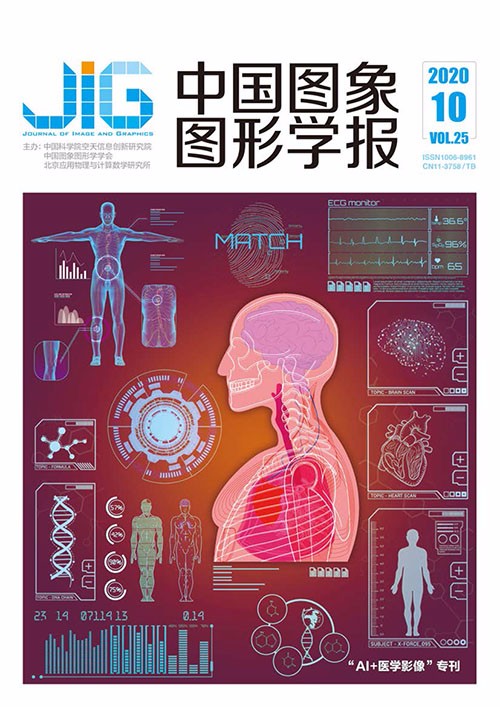
乳腺超声肿瘤动态噪声指数及分割算法
摘 要
目的 深度学习在各种语义分割任务中取得了优异的性能,但需要大量带有准确标注的训练样本。乳腺超声由于其成像特点,导致图像对比度和分辨率低、斑点噪声较高、组织间边界模糊等,这些问题导致精确标注十分困难。超声分割数据集中存在较多非准确的标注,这些数据即标注噪声。若训练集中包含一定量的噪声,将会极大地影响网络的分割准确度。为了解决该问题,提出了一种针对超声图像的动态噪声指数及分割算法,实现在乳腺超声数据包含噪声的情况下肿瘤区域的准确分割。方法 针对超声图像的噪声特点提出动态噪声指数(dynamic noise index,DNI);在网络训练过程中实时更新DNI,并在每次迭代结束后计算整个训练集的DNI分布,进而实现对噪声数据的可检测;提出一个改进的损失函数以增强网络噪声检测性能,同时结合DNI降低噪声对训练反向传播的影响。最后本文将动态噪声指数和改进的损失函数联合形成一个噪声容忍框架,该框架可以应用于其他分割网络。结果 本文将噪声容忍框架和多种分割网络进行结合,并在两个数据集上进行实验。公开数据集的实验结果显示,增加噪声容忍框架的网络相比于原网络各指标提高了8%~12%。本文构建了一个包含1 805幅图像的乳腺超声肿瘤分割数据集,结合噪声容忍框架之后的网络各指标也取得了4%~7%的提升。结论 本文提出的动态噪声指数及分割算法针对不同噪声比例的训练数据集,对噪声均能有效地抑制,并取得稳定的分割性能。
关键词
Dynamic noise index and segmentation algorithm for breast ultrasound tumor
Zou Haipeng1, Gong Xun1, Hu Bijie1, Luo Jun2(1.School of Information Science and Technology, Southwest Jiaotong University, Chengdu 610031, China;2.Sichuan Academy of Medical Sciences, Sichuan Provincial People's Hospital, Chengdu 610072, China) Abstract
Objective Breast cancer has become one of the highest mortality rates in women. The incidence rate of breast cancer has been increasing in recent years. Early diagnosis of breast cancer is the key to treatment and control. Clinical data show that early diagnosis can reduce the mortality by 40%. Medical ultrasound has high accuracy, without trauma and radiation to the body, and requires extremely low cost. Therefore, ultrasound is often used as the first choice in medical diagnosis. Computer-aided diagnosis combines the powerful analysis and calculation ability of computers with medical image processing, thereby immensely improving the working efficiency and reducing the missed diagnosis and misdiagnosis. Deep learning has achieved excellent performance in various semantic segmentation tasks, and its accuracy is far beyond the traditional method. A common application of deep learning is focus segmentation. The focus area is the location of the lesion, which is usually part of the entire ultrasound image. Before diagnosis, the focus area is divided as the region of interest. On the one hand, it can reduce the amount of computation to improve the speed of the algorithm. On the other hand, it can reduce the background interference to improve the accuracy of the algorithm. The training of deep learning needs a large number of training samples with accurate labels. The precise location and segmentation of the focus area need to be manually labeled. Breast ultrasound results in low contrast and resolution, high speckle noise, and blurry boundary between tissues because of its imaging characteristics. These problems make accurate labeling extremely difficult. At present, breast ultrasound is the common method for experienced doctors to accurately label the focus area. However, this labor-intensive work aggravates the workload of doctors and seriously affects the diagnosis efficiency of doctors. Thus, studying the automatic location and segmentation of the focus area in ultrasound images is of great significance. Although the ultrasonic segmentation data set marked by doctors is uncleaned many times, many inaccurate marks are found in the data set, which are called mark noise. The training set will immensely affect the accuracy of network segmentation when it contains a certain amount of noise. To solve this problem, this paper proposes a dynamic noise index (DNI) and a novel loss function to achieve the segmentation of breast ultrasound tumor in noisy environment. Method In this paper, DNI is proposed to realize the detectability of noise. The DNI is then updated in real time during network training. At the end of each iteration, the DNI distribution of the entire training set is calculated. The detection of noise data is realized through the monitoring of data distribution. This paper proposes an improved loss function to enhance the performance of network noise detection. This loss function combines DNI to reduce the influence of noise on training back propagation. To verify the effectiveness of the algorithm, the DNI and the improved loss function are combined to form a noise tolerance framework. The framework can be applied to all types of segmented networks. The experiment is designed into two datasets, namely, open breast tumor segmentation dataset of Breast Ultrasound Images (DBUI) and Noisy Breast Ultrasound Image Dataset (NBUID). NBUID consists of 1 305 rough labeled breast tumor images. The validation and test sets consist of 500 exact annotation samples. Five hundred samples cover different nodule shapes (round, elliptical, irregular, lobulated, etc.), different nodule sizes, different nodule boundaries, different internal echoes, and different growth sites. 350 of them are test sets, and 150 are verification sets. Result In this paper, the noise tolerance framework is combined with three segmentation networks, namely, U-net, PSPNet, and FastFCN. The test results of DBUI30 show that the network with noise tolerance framework is 8%~12% higher than the original network. This paper constructs a data set of 1 805 images of breast ultrasound tumor segmentation. Combined with the noise tolerance framework, the performance of the network is improved by 4%~7%. Conclusion The proposed DNI and segmentation algorithm can effectively suppress noise and achieve stable segmentation performance for training data sets with different noise ratios.
Keywords
|



 中国图象图形学报 │ 京ICP备05080539号-4 │ 本系统由
中国图象图形学报 │ 京ICP备05080539号-4 │ 本系统由